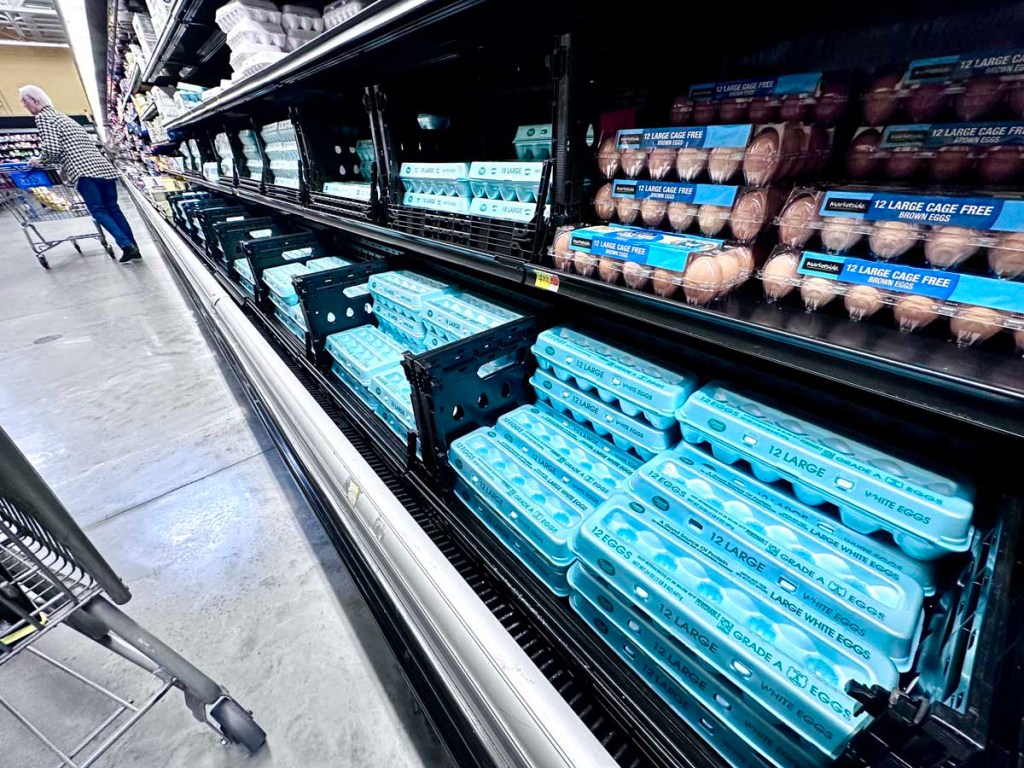Cracking the mystery: Why is the price of eggs so high?
Published 5:00 pm Sunday, January 8, 2023

- On Thursday, Jan. 5, 2023, a dozen eggs at Walmart on Highway 157 cost $4.92. In July 2021, the cost was a $1.28. Today, the price is $2.07
The numbers tell the tale: On July 24, 2021, a dozen plain eggs at the Cullman Walmart on Alabama Highway 157 cost a post-tax total of $1.28. On Thursday, Jan. 5, 2023, that same carton of eggs now shows up on the same Walmart’s store receipt at a total of $4.92.
That’s a nearly fourfold price jump, and it’s not exclusive only to one grocery retailer — or only to eggs of the basic, mass-grown variety. Organic and pasture-raised eggs from smaller farms, which always command their own bespoke-food premium, have surged along with the rest, putting eggs across the board among the most dramatically more-expensive food staples during an inflationary period that’s seen a broader jump in the cost of general groceries overall.
Trending
It’s enough to make some locals finally commit to the idea of raising their own backyard hens, a trend that’s lately sent more residents through the doors at Tractor Supply and Chambers Farm and Garden Supply in Cullman in search of their first-ever brood of chicks. But that, said Cullman County Extension agent Kira Sims, typically comes with its own sticker shock — and most of all for first-timers.
“People do need to be aware that you’re probably not going to really save a lot of money on eggs, especially if you’ve never raised chickens before,” said Sims. “If you’re starting from scratch, you’re buying a coop; you’re buying the feed; you’re buying the feeder. Then they need a warm place in winter, so you’re buying a heat lamp. Plus, you feed chicks for four months before they start laying eggs — so there’s that initial period of no production where you aren’t getting a return on your investment.”
Though Cullman is known for chicken, local factors barely crack the surface of the industrial-scale network of economic contingencies that affect the price of all but the most boutique, hyper-locally grown-and-sold eggs.
In Alabama, you can count on one hand the number of commercial egg operations that supply eggs at scale to food service companies and grocery chains. Local grower Lee Haynes operates one of those commercial operations from his farm not far from Fairview, and said the U.S. egg industry operates at the mercy of economic movements that are national — and even international — in scope.
“Egg prices are set on a daily supply and demand-based market. As producers, we do not set the price of eggs,” Haynes said. “It’s a daily market that most everybody in the U.S. bases their prices off of.”
Before last year, the inflationary effects of COVID-19 and the resulting federal stimulus response already had egg growers incrementally facing higher costs to maintain their supply in the face of unwavering consumer demand. Then last spring, U.S. farmers — especially in the west and midwest — experienced a new strain of avian influenza among their flocks, a disease whose tightly regulated federal oversight can yield dramatic results.
Trending
“If a farm is infected with avian influenza, or if it’s detected, then all the birds at that farm are culled to help prevent the spread of the virus,” said Haynes, noting that no commercial Alabama egg grower has so far encountered the issue in the ongoing current outbreak.
“The current price increase is mainly due to an avian influenza outbreak across the country in which more than 40 million hens have been lost,” he said, noting that a total of 50 million birds — including a smaller portion of the nation’s meat-producing poultry flock — have been culled. “It’s had a significant impact on the supply of eggs in the U.S., and really tightened up supplies and therefore increased the price. It’s been going on for nearly a year now. But the most recent spike in price that we’ve seen was also during a time of the year when demand for eggs has been highest — through the holiday season.”
Whether human or avian, or even porcine, flu seems to be a perennial media fascination, anyone who’s been checking the news for the past decade is likely used to seeing “bird flu” among the headlines. So what makes the past year’s bout with avian influenza any different?
“What we’re dealing with right now has been in Asia and Europe for the last several years, where it has been a big problem,” said Haynes. “That strand made its way here, and the majority of infections we’re dealing with right now are that strain of H5N1.”
In addition to that, he said, the infection pattern from the current avian influenza outbreak — spread through seasonal migration of wild birds that carry the virus but aren’t affected by it — hasn’t remained limited to just one period.
“In 2015, we had a large outbreak of avian influenza in the US. It kind of came through in the spring migration north, but it didn’t return in the fall,” said Haynes. “Whereas this time, we had it in the spring migration north, and then again in the fall migration south. I’d say poultry producers in the south are still at risk at this time — but we’ll see what lies ahead.”
With 40 million hens culled nationwide, the supply of eggs has tightened even as demand for them has remained constant and had even momentarily heightened through the holidays. But avian influenza isn’t the sole contributor to the increased cost of grocery store eggs; it’s simply the latest exacerbating one.
“Egg prices were already under pressure because of inflation, and from being in high demand, prior to the outbreak,” Haynes said. “The avian influenza outbreak has also been coupled with inflation, and we’ve dealt with extraordinary cost increases on the supply side. We have seen increased costs in trucking and transportation, in packaging materials, and in feed — which is our No. 1 cost.”
Though no Alabama growers have yet faced an avian influenza-imposed flock culling, commercial egg operations in the state aren’t passive observers of wild nature, helplessly waiting for the virus to arbitrarily pass from the migratory bird population into their managed flocks, where it can wreak potential havoc.
“The main way it’s believed that avian influenza is spread around the country is through migratory waterfowl and shorebirds,” said Haynes. “If they bring it into an area, then other types of wild birds — vultures and raptors and things like that — may feed on the carcasses of waterfowl and can be infected as well.
“We encourage all producers in our area to continue to be vigilant,” he said. “We’re proud of having done a good job in combatting this. It’s important to practice proper biosecurity, and to not allow yourself or anyone else who enters your farm, or, obviously, your birds’ habitat, to come into contact with any other birds — especially migratory waterfowl or shorebirds, which is how avian influenza spreads.”





